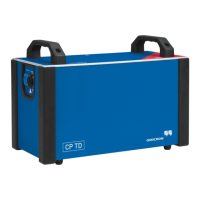CP TD1 Reference Manual V 1.44
98
be made on the insulation between the tap and the flange. Most manufacturers
list the UST dissipation factor and capacitance values on the bushing
nameplate.
Figure 7-4 UST bushing test (C1)
When bushings with capacitance or potential taps rated at 110 kV and above are
tested by the ungrounded test specimen method, a separate dissipation factor
test on the tap insulation should be performed as well.
For capacitance or potential taps, tests are performed at a voltage between 500
and 1,000 volts. The tap is energized with the bushing center conductor and
flange grounded. The dissipation factor of a capacitance or potential tap will
generally be of the order of 1.0 percent or less. Routine tap insulation tests are
not normally recommended for bushings that are rated 69 kilovolts and below
with dissipation factor taps. However, a dissipation factor test of the tap
insulation should be performed when UST results are questionable or visual
examination indicates the dissipation factor tap's condition is questionable. This
test procedure is similar to that used earlier for capacitance taps. In such cases,
the maximum permissible test potentials should be limited to those given in the
UST-A
Equalizers
C1 Layer
Voltage tap
Mounting flange
C2 layer (always
grounded to flange)
Paper insulation
IN A
IN B
Main conductor

